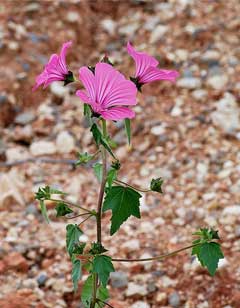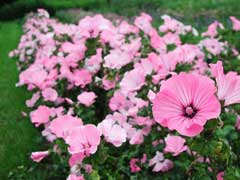 |
|
http://commons.wikimedia.org/wiki/User:Alvesgaspar |
 |
| http://www.flickr.com/people/62528187@N00 |
Translate this page:
Summary
Physical Characteristics

 Lavatera trimestris is a ANNUAL growing to 0.8 m (2ft 7in) by 0.5 m (1ft 8in) at a fast rate. It is in flower from July to September. The species is hermaphrodite (has both male and female organs) and is pollinated by Insects.
Lavatera trimestris is a ANNUAL growing to 0.8 m (2ft 7in) by 0.5 m (1ft 8in) at a fast rate. It is in flower from July to September. The species is hermaphrodite (has both male and female organs) and is pollinated by Insects.
It is noted for attracting wildlife.
Suitable for: light (sandy) and medium (loamy) soils, prefers well-drained soil and can grow in nutritionally poor soil. Suitable pH: mildly acid, neutral and basic (mildly alkaline) soils. It cannot grow in the shade. It prefers dry or moist soil. The plant can tolerate maritime exposure.
UK Hardiness Map
US Hardiness Map
Synonyms
Plant Habitats
Cultivated Beds;
Edible Uses
Edible Parts: Leaves Oil
Edible Uses: Oil
Young leaves - cooked[177].
References More on Edible Uses
Medicinal Uses
Plants For A Future can not take any responsibility for any adverse effects from the use of plants. Always seek advice from a professional before using a plant medicinally.
None known
References More on Medicinal Uses
The Bookshop: Edible Plant Books
Our Latest books on Perennial Plants For Food Forests and Permaculture Gardens in paperback or digital formats.

Edible Tropical Plants
Food Forest Plants for Hotter Conditions: 250+ Plants For Tropical Food Forests & Permaculture Gardens.
More

Edible Temperate Plants
Plants for Your Food Forest: 500 Plants for Temperate Food Forests & Permaculture Gardens.
More

More Books
PFAF have eight books available in paperback and digital formats. Browse the shop for more information.
Shop Now
Other Uses
Oil
The seed contains up to 11.7% oil. It is greenish coloured with an iodine value of 120.9[74]. The uses of this oil are not given, it is exceedingly unlikely to be poisonous and is therefore probably edible[K].
Special Uses
Attracts Wildlife
References More on Other Uses
Cultivation details
An easily grown plant, succeeding in any ordinary garden soil[1]. Prefers a light well-drained moderately fertile soil in full sun[200]. A soil that is too rich encourages foliar growth at the expense of flowering[200]. Tolerates maritime exposure[200]. Succeeds in dry soils. Plants are moderately fast-growing[188]. A very ornamental plant[1]. The cut flowers last a long time in water[200]. A good bee plant[74].
References Carbon Farming Information and Carbon Sequestration Information
Temperature Converter
Type a value in the Celsius field to convert the value to Fahrenheit:
Fahrenheit:
The PFAF Bookshop
Plants For A Future have a number of books available in paperback and digital form. Book titles include Edible Plants, Edible Perennials, Edible Trees,Edible Shrubs, Woodland Gardening, and Temperate Food Forest Plants. Our new book is Food Forest Plants For Hotter Conditions (Tropical and Sub-Tropical).
Shop Now
Plant Propagation
Seed - sow in situ in the spring[200]. Germination should take place within a few weeks.
Other Names
If available other names are mentioned here
Native Range
TEMPERATE ASIA: Israel, Jordan, Lebanon, Syria, Turkey EUROPE: Greece, Italy (incl. Sardinia, Sicily), Spain (incl. Baleares), France, Portugal AFRICA: Algeria (north), Morocco, Tunisia
Weed Potential
Right plant wrong place. We are currently updating this section.
Please note that a plant may be invasive in one area but may not in your area so it's worth checking.
Conservation Status
IUCN Red List of Threatened Plants Status :

Growth: S = slow M = medium F = fast. Soil: L = light (sandy) M = medium H = heavy (clay). pH: A = acid N = neutral B = basic (alkaline). Shade: F = full shade S = semi-shade N = no shade. Moisture: D = dry M = Moist We = wet Wa = water.
Now available:
Food Forest Plants for Mediterranean Conditions
350+ Perennial Plants For Mediterranean and Drier Food Forests and Permaculture Gardens.
[Paperback and eBook]
This is the third in Plants For A Future's series of plant guides for food forests tailored to
specific climate zones. Following volumes on temperate and tropical ecosystems, this book focuses
on species suited to Mediterranean conditions—regions with hot, dry summers and cool, wet winters,
often facing the added challenge of climate change.
Read More
Expert comment
Author
L.
Botanical References
50200
Links / References
For a list of references used on this page please go here
Readers comment
| Add a comment |
|
If you have important information about this plant that may help other users please add a comment or link below. Only comments or links that are felt to be directly relevant to a plant will be included. If you think a comment/link or information contained on this page is inaccurate or misleading we would welcome your feedback at [email protected]. If you have questions about a plant please use the Forum on this website as we do not have the resources to answer questions ourselves.
* Please note: the comments by website users are not necessarily those held by PFAF and may give misleading or inaccurate information.
To leave a comment please Register or login here All comments need to be approved so will not appear immediately.
|
Subject : Lavatera trimestris
|
|
|
|